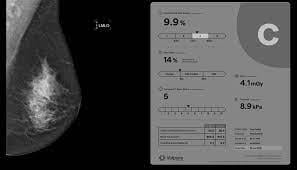
December 22, 2023 — Volpara Health Technologies Ltd., a global leader in software for the early detection and prevention of cancer, was featured in two peer reviewed studies published during this year's Radiological Society of North America (RSNA) annual meeting.
Transforming the breast dose model
The prestigious Joint AAPM Task Group 282/EFOMP Working Group, focused on modernizing breast radiation dose modeling, recently published a report outlining their new model in Medical Physics. The report, "Breast dosimetry for standard and contrast-enhanced mammography and breast tomosynthesis," advocates for international harmonization of mammography dose estimates, by implementation of the new and improved model and methodology. The new model replaces assumptions of a homogeneous breast with a more representative fibroglandular tissue distribution and shifts to the use of percentage volumetric breast density (%VBD) to align with a clinically implemented breast composition metric. Volumetric breast density emerges as an essential input to facilitate patient-based radiation dose estimates. Volpara's TruDensity algorithm provides reliable estimates of %VBD from 2D and 3D images across multiple mammography system makes and models.
Ioannis Sechopoulos, first author of the report and Chair of the Joint TG/WG remarks that he, "welcomes and encourages wide adoption of the new breast dosimetry model by the medical physics community and industry, to offer improved and consistent radiation dose estimates in mammography."
This new dose model will be integrated into Volpara's TruRadDose algorithm, which analyzes a patient's exposure to radiation from a mammogram, with the aim of ensuring patient safety while maintaining optimal image quality.
Enhancing radiographers' performance
Featured in European Radiology, a second peer-reviewed study investigates whether active use of Volpara Analytics software could help breast radiographers to improve their screening image quality. The paper "Using automated software evaluation to improve the performance of breast radiographers in tomosynthesis screening," reports on analysis of a quality improvement project where radiographers and researchers from the Breast Radiology Unit at the Veneto Institute of Oncology, encouraged active use of Analytics and led monthly face-to-face coaching sessions with each of six participating radiographers to review individualized feedback based on the objective breast compression and positioning quality metrics measured by Volpara's TruPressure and TruPGMI AI algorithms. All radiographers improved their performance, with increases in quality scores of up to 16% compared to a baseline measurement. The study concluded that employing Volpara's AI-driven software significantly enhances radiographers' performance, thereby improving mammography quality and potentially leading to better screening outcomes for patients. The study's lead author, Gisella Gennaro, notes that a key aspect of the project was to determine whether use of Volpara Analytics software by even the most senior radiographers, would be both accepted and beneficial. She comments that the quality of "all radiographers benefited from the personalized learning experience, with consistent and objective measurements that can be benchmarked against peers."
Research is essential to AI adoption
"Increased adoption of AI in clinical practice is reliant on quality research demonstrating evidence of improved outcomes and/or practice efficiencies. By empowering clinicians with innovative tools, Volpara exemplifies its commitment to advancing mammography quality and the early detection of breast cancer," said Melissa Hill, Volpara Health Senior Imaging Scientist and Global Research Lead.
Volpara strives for continuous advancements in AI for breast care, which aligns with the company's mission to save more families from cancer.
For more information: www.volparahealth.com
Find more RSNA23 conference coverage here
Related Breast Density Content:
VIDEO: FDA Update on the US National Density Reporting Standard - A Discussion on the Final Rule
One on One … with Wendie Berg, MD, PhD, FACR, FSBI
Task Force Issues New Draft Recommendation Statement on Screening for Breast Cancer
Creating Patient Equity: A Breast Density Legislative Update
AI Provides Accurate Breast Density Classification
VIDEO: The Impact of Breast Density Technology and Legislation
VIDEO: Personalized Breast Screening and Breast Density
VIDEO: Breast Cancer Awareness - Highlights of the NCoBC 2016 Conference
Fake News: Having Dense Breast Tissue is No Big Deal
The Manic World of Social Media and Breast Cancer: Gratitude and Grief
Additional Breast Imaging and Related Content:
Single vs. Multiple Architectural Distortion on Digital Breast Tomosynthesis
Today's Mammography Advancements
Digital Breast Tomosynthesis Spot Compression Clarifies Ambiguous Findings
AI DBT Impact on Mammography Post-breast Therapy
ImageCare Centers Unveils PINK Better Mammo Service Featuring Profound AI
Radiologist Fatigue, Experience Affect Breast Imaging Call Backs
Fewer Breast Cancer Cases Between Screening Rounds with 3-D Mammography
Study Finds Racial Disparities in Access to New Mammography Technology


 December 10, 2025
December 10, 2025 








